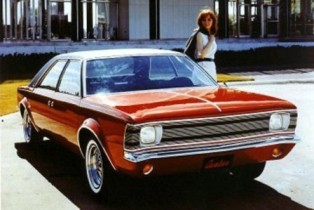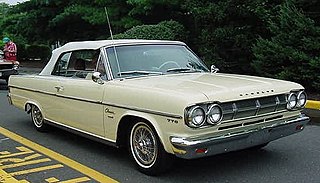 W
WThe Ambassador is an automobile manufactured and marketed by American Motors Corporation (AMC) from 1957 to 1974 over eight generations, in two- and four-door sedan, two-door hardtop, station wagon and convertible body styles. It was full-size from 1957 to 1961 and 1967 to 1974, and mid-size from 1962 to 1966.
 W
WThe Nash Ambassador is a luxury automobile that was produced by Nash Motors from 1927 until 1957. For the first five years it was a top trim level, then from 1932 on a standalone model. Ambassadors were lavishly equipped and beautifully constructed, earning them the nickname “the Kenosha Duesenberg".
 W
WThe Nash 600 is an automobile that was manufactured by the Nash-Kelvinator Corporation of Kenosha, Wisconsin for the 1941 through 1949 model years, after which the car was renamed the Nash Statesman. The Nash 600 was positioned in the low-priced market segment. The "600" name comes from the car's advertised ability to go 600 miles (970 km) on one tank of gasoline. Introduced for the 1941 model year, the Nash 600 became the first mass-produced unibody constructed car built in the United States.
 W
WThe AMC Amitron was an experimental electric subcompact car built in 1967 by American Motors Corporation (AMC) and Gulton Industries. It included many advanced features, including regenerative braking and advanced battery designs, to provide a 150-mile (240 km) range on a single charge. Development ended because of technology issues and the high cost of batteries.
 W
WThe Rambler American is a compact car that was manufactured by the American Motors Corporation (AMC) between 1958 and 1969. The American was the second incarnation of AMC forerunner Nash Motors' second-generation Rambler compact that was sold under the Nash and Hudson Motors marques in 1954 and 1955.
 W
WThe AMC AMX is a two-seat GT-style muscle car produced by American Motors Corporation from 1968 through 1970. As one of just two American-built two-seaters, the AMX was in direct competition with the one-inch (2.5 cm) longer wheelbase Chevrolet Corvette, for substantially less money.
 W
WThe AMC AMX/3 is a mid-engine sports car made by the United States Automobile manufacturer American Motors Corporation (AMC), which was presented in March 1970 and was to be mass-produced in Germany by Karmann from 1971. With this car, AMC wanted to counter the similarly designed De Tomaso Pantera with a competitor. The body design and drivetrain came from AMC, the chassis and suspension were developed in Europe. The design was generally attributed to Giotto Bizzarrini. However, only individual components such as the suspension come from him. In addition to Bizzarrini, Italdesign, Autocostruzioni S.D. and BMW were also involved in the development. Shortly after the presentation, AMC abandoned the project without giving any reason, after about half a dozen cars had been created. Several attempts to revive the design without AMC involvement under the Bizzarrini brand name - including as the Bizzarrini Sciabola - were unsuccessful. An AMX/3 chassis formed the technical basis for the Iso Varedo concept car in 1972.
 W
WThe AMC AMX-GT is a concept car that was developed by American Motors Corporation (AMC) for the 1968 show car circuit. The design of the grand touring-type rear-wheel-drive pillarless coupe of monocoque construction with two doors and a truncated rear end treatment was influenced by AMC stylist Dick Teague.
 W
WThe XR-400 was a fully operational concept car. A "sporty" youth-oriented convertible was built in 1962 by the Budd Company, an independent body builder in Detroit, Michigan, for evaluation by the fourth largest U.S. automaker at the time, American Motors Corporation (AMC). The phrase "ahead of its time" applies to this proposed vehicle.
 W
WThe AMC Cavalier was a concept compact car made by American Motors (AMC) in 1965. It was innovative by its symmetrical design and use of interchangeable body parts.
 W
WThe AMC Concord is a compact car manufactured and marketed by the American Motors Corporation for model years 1978-1983. The Concord was essentially a revision of the AMC Hornet that was discontinued after 1977, but more luxurious, quieter, roomier, and smoother-riding than the series it replaced. It was offered in four-door sedan, two-door coupé, three-door hatchback, and five-door station wagon configurations. The Concord was AMC's volume seller from the time it appeared until the introduction of the Renault Alliance.
 W
WThe AMC Eagle is a compact four-wheel drive passenger vehicle manufactured and marketed by American Motors Corporation (AMC) model years 1980 to 1987 and Chrysler Corporation, following its acquisition of AMC in 1987, for the 1988 model year.
 W
WThe AMC Gremlin is a subcompact automobile introduced in 1970, manufactured and marketed in a single, two-door body style (1970–1978) by American Motors Corporation (AMC), as well as in Mexico (1974–1978) by AMC's Vehículos Automotores Mexicanos (VAM) subsidiary.
 W
WThe AMC Hornet is a compact automobile, manufactured and marketed by American Motors Corporation (AMC) and made from 1970 through 1977 — in two- and four-door sedan, station wagon, and hatchback coupe configurations. The Hornet replaced the compact Rambler American line, marking the end of the Rambler marque in the American and Canadian markets.
 W
WHudson Hornet is a full-sized automobile that was manufactured by Hudson Motor Car Company of Detroit, Michigan from 1951 until 1954, when Nash-Kelvinator and Hudson merged to form American Motors Corporation (AMC). Hudson automobiles continued to be marketed under the Hudson brand name through the 1957 model year.
 W
WThe Hudson Italia is an automobile styling study and a limited production two-door compact coupé that was produced by the Hudson Motor Car Company of Detroit, Michigan, in cooperation with Carrozzeria Touring of Italy, and subsequently marketed by American Motors Corporation during the 1954 and 1955 model years. Designed by Frank Spring with input from Carlo Felice Bianchi Anderloni of Carrozzeria Touring, and introduced 14 January 1954, the Italia was based on the Hudson Jet platform and running gear, but with a unique body and interior.
 W
WThe Hudson Jet is a compact automobile that was produced by the Hudson Motor Car Company of Detroit, Michigan, during the 1953 and 1954 model years. The Jet was the automaker's response to the popular Nash Rambler and the costs of developing and marketing the Jet ultimately led to Hudson's merger with Nash.
 W
WHudson Rambler is an automobile nameplate applied to two distinct vehicles:Small-sized car also marketed as the Nash Rambler Large-sized car also marketed as the Rambler Six and V8
 W
WThe Hudson Wasp is an automobile that was built and marketed by the Hudson Motor Car Company of Detroit, Michigan, from the 1952 through the 1956 model years. After Hudson merged with Nash Motors, the Wasp was then built by American Motors Corporation in Kenosha, Wisconsin, and marketed under its Hudson marque for model years 1955 and 1956.
 W
WThe AMC Javelin is an American front-engine, rear-wheel-drive, two-door hardtop automobile manufactured and marketed by American Motors Corporation (AMC) across two generations, 1968–1970 and 1971–1974 model years.
 W
WThe Jeep CJ models are both a series and a range of small, open-bodied off-road vehicles and compact pickup trucks, built and sold by several successive incarnations of the Jeep automobile marque from 1945 to 1986. The 1945 Willys Jeep was the world's first mass-produced civilian four-wheel drive car.
 W
WThe Rambler Marlin is a two-door fastback automobile produced in the United States by American Motors Corporation from 1965 to 1967. A halo car for the company, it was marketed as a personal luxury car.
 W
WThe AMC Matador is a car model line that was manufactured and marketed by American Motors Corporation (AMC) across two generations, 1971–1973 (mid-size) and 1974–1978 (full-size), in two-door hardtop and coupe versions as well as in four-door sedan and station wagon body styles.
 W
WThe Nash Metropolitan is an American automobile that was assembled in England and marketed from 1953 to 1961.
 W
WThe M422 'Mighty Mite' is a lightweight ¼-ton 4x4 tactical truck, suitable for airlifting and manhandling. From 1959 to 1962, the Mighty Mite was built by American Motors for the United States Marine Corps.
 W
WThe AMC Pacer is a two-door compact car produced in the United States by American Motors Corporation (AMC) from the 1975 to 1980 model years. The Pacer was also made in Mexico by Vehículos Automotores Mexicanos (VAM) from 1976 to 1979 and positioned as a premium-priced luxury car.
 W
WRambler is an automobile brand name that was first used by the Thomas B. Jeffery Company between 1900 and 1914.
 W
WThe Rambler Classic is an intermediate sized automobile that was built and sold by American Motors Corporation (AMC) from the 1961 to 1966 model years. The Classic took the place of the Rambler Six and Rambler Rebel V-8 names, which were retired at the end of the 1960 model year.
 W
WThe Rambler Rebel is an automobile that was produced by the American Motors Corporation (AMC) of Kenosha, Wisconsin for the 1957–1960 model years, as well as again for 1966 and 1967.
 W
WThe Rambler Six and the Rambler V8 are intermediate sized automobiles that were built and marketed by American Motors Corporation (AMC) from 1956 to 1960.
 W
WThe Nash Rambler is a North American automobile that was produced by the Nash Motors division of Nash-Kelvinator Corporation from 1950 to 1954 in sedan, wagon, and fixed-profile convertible body styles.
 W
WThe AMC Rebel is a midsized car produced by American Motors Corporation (AMC) from 1967 to 1970. It replaced the Rambler Classic. The Rebel was replaced by the similar AMC Matador for the 1971 model year. The Rebel was positioned as the high-volume seller in the independent automaker's line of models.
 W
WThe AMC Spirit is a subcompact marketed by American Motors Corporation (AMC) from 1979 to 1983 as a restyled replacement for the Gremlin. The Spirit shared the Gremlin's platform and was offered in two hatchback variations, each with two doors – marketed as sedan and liftback. Manufactured by AMC in Wisconsin and Ontario, as well as under license in Mexico, the Spirit was also marketed from 1981 to 1983 as the Eagle SX/4 with four-wheel drive.
 W
WThe Rambler Tarpon was a concept car, a compact-sized sporty youth-oriented 2+2 hardtop coupé developed in 1963 by American Motors Corporation (AMC). The bright red with black roof design study made its public debut 1964 Chicago Auto Show and served to foretell the fastback design elements of the larger Rambler Marlin that was introduced in 1965.
 W
WAMC Machine is an automobile nameplate applied to two vehicles built by American Motors Corporation:The Machine - a high-performance muscle car based on the 1970 AMC Rebel Matador Machine - an option package for the 1971 AMC Matador